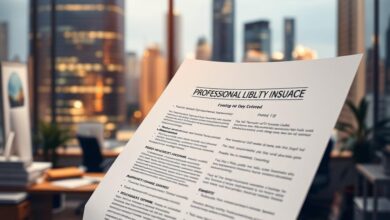Protect Your Business with Professional Liability Insurance
As a business owner, you face many risks that could hurt your finances. One mistake or unexpected event can cause big losses. That’s why professional liability insurance is so important for businesses like yours.
This business insurance protects you from claims of negligence, misrepresentation, or mistakes. It helps keep your business strong when unexpected challenges come up. With the right liability protection, you can keep your business safe.
Key Takeaways
- Professional liability insurance shields your business from financial losses due to mistakes or negligence.
- This type of insurance is key for businesses that offer services or advice.
- Having the right liability protection keeps your business financially stable.
- Business insurance can be customized to fit your business’s needs.
- Protecting your business with professional liability insurance brings peace of mind.
Understanding Professional Liability Errors and Omissions Insurance
Knowing about Professional Liability Errors and Omissions Insurance is key for service-based businesses. It protects them from financial loss due to mistakes or negligence. These mistakes can harm clients financially.
What Professional Liability Insurance Covers
Professional Liability Insurance, or E&O insurance, shields businesses from claims of negligence or misrepresentation. It helps pay for legal costs and damages. For example, if your advice causes a client financial loss, this insurance can help.
How It Differs from General Liability Insurance
General Liability Insurance covers injuries, property damage, and other risks. But Professional Liability Insurance is for professional advice or services. Experts say this difference is critical for protecting businesses from unique risks. It’s important for businesses to know this to stay financially safe.
Why Your Business Needs Professional Liability Protection
Service-based businesses face unique risks that can cause big financial losses. Professional liability protection helps protect your business from these risks. It covers losses due to mistakes, omissions, or negligence in your services.
Common Risks for Service-Based Businesses
Service-based businesses deal with many risks, including:
- Mistakes in advice or guidance provided to clients
- Failure to deliver services as promised
- Misinterpretation of data or information
- Inadequate documentation or record-keeping
These risks can lead to claims of negligence or breach of contract. This can cause big financial losses for your business.
Real-World Claim Scenarios
Here are some real-world examples:
| Scenario | Description | Potential Claim |
|---|---|---|
| Consulting Error | A consultant provides incorrect advice to a client. | Negligence |
| Service Delay | A service provider fails to meet a project deadline. | Breach of Contract |
| Data Misinterpretation | A data analyst misinterprets critical data for a client. | Professional Negligence |
These examples show why professional liability protection is key. It helps reduce the financial impact of such claims.
Assessing Your Business’s Professional Liability Needs
To protect your business, it’s key to check your professional liability needs. You need to know the risks your business faces and find the right insurance.
Industry-Specific Risk Factors
Every industry has its own risk levels for professional liability. Knowing these risks helps you choose the right insurance.
Evaluating Your Client Contracts
Looking at your client contracts is also important. Check for clauses that make you pay for clients’ losses or limit your liability.
Determining Appropriate Coverage Limits
Finding the right coverage limits means thinking about claim costs. This includes legal fees, damages, and other expenses. Also, think about your business’s financial health and how much risk you can handle.
| Industry | Typical Coverage Limit | Regulatory Requirements |
|---|---|---|
| Medical Professionals | $1 million – $3 million | Often required by law or licensing boards |
| Legal Professionals | $1 million – $5 million | May be required by state bar associations |
| Consultants/Coaches | $500,000 – $1 million | Varies; often contractually required by clients |
By carefully checking your business’s professional liability needs, you can make sure you have the right insurance. This protects your business from risks.
Steps to Find the Right Professional Liability Errors and Omissions Insurance
To protect your business, follow a systematic approach when looking for professional liability errors and omissions insurance. This involves several key steps. They help you find the best coverage for your needs.
How to Research Reputable Insurance Providers
Start by researching reputable insurance providers. Look for insurers with a strong financial rating and efficient claim handling. Check ratings from agencies like A.M. Best or Moody’s to see if they’re financially stable.
Also, ask for recommendations from industry peers or professional associations. They can share insights on insurance companies with a good reputation in your field.
Getting and Comparing Multiple Quotes
After finding possible insurance providers, get and compare multiple quotes. Make sure each quote has the same coverage limits and deductibles for a fair comparison. Use online tools or an insurance broker to gather quotes from different insurers.
When comparing, look at the premium costs and coverage details. Check for any exclusions or limitations.
Reading Policy Details Carefully
After getting quotes, carefully read the policy details. Understand the policy language and watch for any red flags.
Understanding Policy Language
The policy language should be clear and easy to understand. It should explain what’s covered and what’s not. Make sure you know the conditions for making a claim.
Identifying Red Flags
Be wary of policies with broad exclusions or those that seem too good to be true. Check if the policy covers defense costs and understand the claim filing process.
| Insurance Provider | Coverage Limit | Deductible | Premium Cost |
|---|---|---|---|
| Provider A | $1,000,000 | $1,000 | $500 |
| Provider B | $2,000,000 | $2,500 | $800 |
| Provider C | $1,500,000 | $1,500 | $650 |
By following these steps, you can make an informed decision. This ensures your business is well-protected against risks.
How to Compare Professional Liability Insurance Policies
Protecting your business is key. Comparing professional liability insurance policies is a big step. You need to look at different policies to find the best one for your business.
Key Policy Features to Evaluate
When you compare policies, look at a few important things. Check the coverage limits, deductible amounts, and what the policy covers. Make sure the policy protects all your business services and risks.
Coverage Limits and Deductibles are very important. Higher limits mean more protection but cost more. Lower deductibles mean you pay less upfront but might cost more overall.
Understanding Exclusions and Limitations
Every policy has things it doesn’t cover. It’s important to know these to avoid surprises. Common things not covered include damages from intentional acts, contractual liabilities, and some professional services.
Balancing Cost vs. Coverage
Finding the right balance between cost and coverage is tricky. Don’t just choose the cheapest policy. Make sure the policy you choose offers enough protection. Compare not just the cost but also the coverage value.
| Policy Feature | Policy A | Policy B |
|---|---|---|
| Coverage Limit | $1 million | $2 million |
| Deductible | $1,000 | $500 |
| Premium Cost | $800/year | $1,200/year |
By carefully looking at these points, businesses can make smart choices. They can find a policy that offers the right mix of cost and coverage.
Purchasing and Implementing Your Professional Liability Policy
After figuring out your business needs, it’s time to buy and use your professional liability insurance. This step involves several important actions to make sure you have the right coverage.
Navigating the Application Process
The application for professional liability insurance can be tricky. You need to give accurate and detailed info about your business, services, and how you manage risks. Insurance companies will use this info to figure out your premium and what you’re covered for. To make the application smoother, have these documents ready:
- Business description and service details
- Financial statements
- Details of existing insurance policies
- Information on any previous claims
Integrating Insurance into Your Business Operations
After you get your policy, it’s key to make it part of your business. This means:
Staff Training on Coverage Limitations
Teach your staff about what your policy covers and what it doesn’t. This helps everyone know what’s protected and what’s not. It also lowers the chance of claims that aren’t covered.
Documentation Practices to Support Claims
Start keeping detailed records to back up any claims. Keep track of client talks, project info, and any service-related communications. Good records can really help your case if a claim comes up.
Conclusion
Professional liability insurance is key for businesses that offer services or advice. It protects against expensive lawsuits and financial losses. These can happen due to alleged negligence or errors.
Knowing your insurance coverage needs and picking the right professional liability insurance policy is vital. It helps keep your business’s reputation and finances safe.
It’s important to assess your business risks and check client contracts. You also need to figure out the right coverage limits. By doing these steps and working with a trusted insurance provider, your business will be well-protected.
In today’s world, the right insurance can prevent big financial problems. Make smart choices about your insurance coverage to protect your business’s future.









